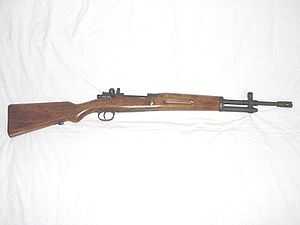FR8
| Santa Barbara FR 8 | |
|---|---|
 | |
| Type | Service Carbine |
| Place of origin | Spain |
| Service history | |
| In service | 1950s-1970s |
| Production history | |
| Manufacturer | bolt system: Mauser, barrel: CETME or H&K, refitting: Fabrica De Armas La Coruña |
| Variants | FR 7, FR 8 |
| Specifications | |
| Weight | ca. 3,700 grams (8.2 lb) |
| Length | 960 millimetres (38 in) |
| Barrel length | 470 millimetres (19 in) |
|
| |
| Cartridge | 7.62x51 CETME (FR7),[1][2] 7.62x51 NATO (FR8) |
| Caliber | .308 (7.62 mm) |
| Action | Bolt action |
| Feed system | 5-round internal magazine |
| Sights | 3 diopters or notch (selectable) and front sight |
The FR 7 and FR 8 are bolt-action, repeating rifles adopted by Spain in the 1950s. The "FR" stands for the Spanish words, Fusil Reformado or Converted Rifle in English.[3] The FR 7 is a variant of the "Spanish M93 Mauser" bolt action while the FR 8 is based on the "Mauser System 98" bolt action. Due to their light weight, short barrel and the calibre used, their recoil and muzzle blast are relatively heavy.
History
The FR7 and FR8 were introduced in the 1950s when the Spanish military was already implementing the CETME automatic rifle, but did not yet have sufficient inventory to equip and train all troops. The rifles were made from existing stockpiles of Mauser bolt-action rifles. The FR-7 was a modification of the Model 1916 short rifle, which in turn was based on the Mauser Model 1893. These three rifles are often referred to as being "small ring" Mausers, as the receiver ring is smaller in diameter than the latter Model 1898 by .110-inch (1.410 inches vs. 1.300 inches).[4] The FR-8 was developed from the Model 1943 short rifle, which was based on "large ring" Model 1898 Mauser action. Both rifles were modified to fire the 7.62×51mm CETME and 7.62x51mm NATO rounds.[5][6][7] The FR 8 was used well into the 1970s by mounted Guardia Civil units in the Sierra Nevada
Scout Rifle Influence
The FR-7/FR-8 is an example of the type of carbine recommended by Jeff Cooper as a Scout rifle in the early 1970s, and bears a strong resemblance to the Ruger Gunsite Scout Rifle introduced in 2010.
Features
The flash hider was designed to be compatible with NATO-standard rifle grenades. The under-barrel tube, which resembles the gas cylinder found on automatic weapons, actually serves as the bayonet mount and as storage for cleaning gear. The rear sight is an elevation-adjustable rotary type with aperatures for 200 m (220 yd), 300 m (330 yd) and 400 m (440 yd), as well as an open "V" notch for 100 metres (110 yd). The front sight is elevation-adjustable via a special tool. Operation is identical to the standard Mauser design.
Images
- Mauser K98 - Spanisch FR 8
-

FR 8 - La Coruña
-

FR 8 - La Coruña
-

FR 8 - La Coruña
-

FR 8 - La Coruña
-

FR 8 - La Coruña
-

FR 8 - La Coruña
-

FR 8 - La Coruña
-

Bayonet FR 8 - La Coruña
See also
References
- ↑ Olson, Ludwig (2002). Mauser Bolt Rifles. Brownell & Son. p. 197.
- ↑ Ezell, Edward (1983). Small Arms of The World. Stackpole Books. p. 655. ISBN 0-8117-1687-2.
- ↑ Olson, Ludwig (2002). Mauser Bolt Rifles. Brownell & Son. p. 197.
- ↑ Kuhnhausen, Jerry (1991). The Mauser Bolt Actions- M91 Through M98. Heritage Gun Books. p. 214.
- ↑ http://masterton.us/Unmarked1916
- ↑ http://world.guns.ru/rifle/repeating-rifle/sp/fr-7-fr--e.html
- ↑ http://masterton.us/Gammo
Sources
"Guns Magazine", May 2006, Holt Bodinson; text transcript under www.findarticles.com
- Olson, Ludwig Elmer (2002) [1950]. Mauser Bolt Rifles (3rd ed.). Montezuma, Iowa: F. Brownell & Son. ISBN 978-0-9767409-4-0.
External links
| Wikimedia Commons has media related to FR8. |
- Modern Firearms - FR-7, FR-8
- Surplusrifle.com - What the Hell is That? The Spanish FR-8 Report at the Wayback Machine (archived January 13, 2010)